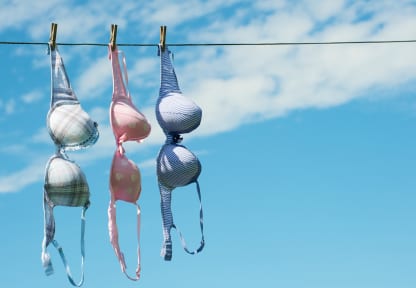
Social norms and preferences aside, it turns out that breast size matters — but not quite in the way you think.
23andMe’s latest research paper, published in the journal BMC Medical Genetics, shows that genetic factors influence whether women have double As or double Ds. This might sound a bit frivolous at first but our research uncovered surprising connections between the genetics of breast size and the genetics of breast cancer.
Analyzing data from more than 16,000 women of European ancestry, we compared their answers to survey questions with their genetic data at millions of SNPs. We found a total of seven genetic factors significantly associated with breast size, three of which are strongly correlated with SNPs already linked to breast cancer.
How do you study breast size anyway?
In our case, no one’s personal space was violated — all of our data was self-reported by female 23andMe customers of European descent who have opted into research and filled out an online survey. We specifically asked about bra cup size as an approximation for breast size using a 10-point scale ranging from “Smaller than AAA” to “Larger than DDD”. We also took into account age, breast-related surgeries (augmentation, reduction, or mastectomy), pregnancy and breastfeeding status, and bra band size (which is correlated with body mass index (BMI)).
Most of the genetic factors we identified for breast size lie in regions of great importance for breast cancer. One of the SNPs, rs12173570, is known to regulate the expression of the estrogen receptor gene, which plays a vital role in breast growth and in the majority of breast cancer cases (known as “ER+” or “hormone positive” types).
Another one of these SNPs, rs7816345, is located in a region of the genome (8p21) that often shows abnormalities in people with a certain subtype of breast cancer. Scientists also recently reported genetic factors influencing breast density — a risk factor for breast cancer — and our research suggests that one of those factors may also be associated with breast size.
These findings show that some of the same biological pathways underlie both normal breast growth and breast cancer. This isn’t a huge surprise if you think of cancer as unrestrained growth. But the relationship between breast size and breast cancer is complicated. Some studies have found that larger breast size as a young woman is associated with a slight increase in breast cancer risk, but only in women who were lean at a young age. The genetic factors we found aren’t enough to explain this association, but support the idea that breast size and breast cancer are related.
While the topic of breast size raised a few eyebrows when we first put out the survey (some thought it was too personal, or couldn’t be serious science), this paper demonstrates that important scientific insights can come from the most unlikely of places. Although the connections between these genetic factors, breast size, and breast cancer aren’t fully understood, our findings give clues to the function of some of these genes and regions that might be useful in combating breast cancer.




